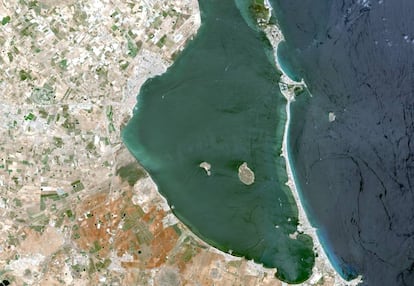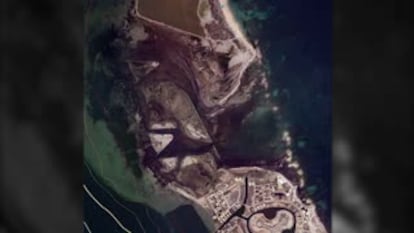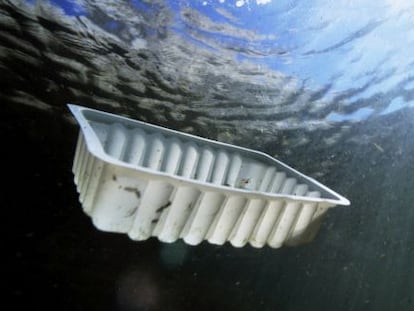Why Spain’s Mar Menor is separating from the Mediterranean Sea
Experts warn the lagoon will be lost forever if urgent structural measures are not taken
The saltwater Mar Menor lagoon in the southeastern region of Murcia is losing its connection with the Mediterranean. Using satellite imagery, a group of researchers has found that the main natural channel connecting both seas is now 80% closed. In addition, using a marine drone, they have measured what is left of the channel. The average depth is barely 25 centimeters. If this entry point for water from the larger adjacent Mediterranean Sea closes, the change in temperature, salinity, chlorophyll levels and water clarity could compromise the future of the lagoon.

The Mar Menor is separated from the Mediterranean by a 20-kilometer long sandbar known as La Manga. There are four breaks along the barrier – a popular tourist area which is between 100 and 900 meters wide. These four channels maintain the connection between both seas and are vital for the inland sea. They regulate the salinity and the temperature of the lagoon and allow for the exchange of marine life. The channels also help to reduce the high levels of nutrients that threaten ecological viability and which would lead to an explosion of algae.
“Since 2009, Las Encañizadas, the main channel in and out of the Mar Menor, has gone from an entry size of 540 meters to 120 meters,” says Manuel Erena, researcher at the Murcia Institute of Agri-Food Research and Development (IMIDA). Half of the narrowing has occurred in the last two years. As for the depth of the canal, “we have gone from 70 centimeters to only 25,” he adds.
The diameter has gone from 540 meters to 120 meters, with half of the narrowing in the last two years
Manuel Erena, researcher
The closing of Las Encañizadas could complicate the lagoon’s delicate ecosystem. Intensive agriculture in the surrounding area has led to an increase in the use of fertilizers. A good part of these minerals, mainly nitrogen and phosphorus, reach the aquifers and, subsequently, the Mar Menor. Both nutrients increase the growth of invasive algae like Caulerpa prolifera and phytoplankton, which gives that greenish hue to a traditionally crystal clear lagoon.
Two other factors that end up polluting the water are the influx of tourists in the summer and the desalination plants. A lot of organic and inorganic matter ends up muddying the waters, which prevents light from reaching the plant bed, the base of the aquatic food chain. “Everything below 1.5 meters in depth dies,” says the researcher.
From May 2015 on, Erena and a group of colleagues from several Spanish and German universities have closely monitored the marine lagoon. Using a probe, they have recorded the evolution of water temperature, salinity, dissolved oxygen, suspended solids, and chlorophyll concentration, which is indicative of algae blossoms and, therefore, one of the main factors in water clarity.
Mar Menor’s ability to defend itself against human aggression completely depends on its connectivity with the adjacent sea Ángel Pérez-Ruzafa, professor of ecology
“What the study of the coastal lagoons and the Mar Menor has taught us is that its ecological state, complexity, and ability to defend itself against human aggression completely depends on its connectivity with the adjacent sea,” explains Ángel Pérez-Ruzafa, professor of ecology at the University of Murcia and president of the scientific advisory committee for the Mar Menor. “If the connection is reduced too much, it will lose its productivity and biological structure. If the communication is too strong, then these are also lost,” he adds.
However, Pérez-Ruzafa believes that the Mar Menor can be saved from being a dead sea. “It has a great capacity for self-regulation and recovery. Its maintenance depends precisely on its communication with the Mediterranean Sea not being excessive, but also not being completely lost,” he says. He adds: “If nutrient intakes are cut and indiscriminate dumping is not carried out, it will recover, as this spring and early summer has showed us. But if urgent structural measures are not taken in the lagoon, we will lose it irrevocably.”
The researchers have created a virtual tour of the area that can be seen here.
English version by Debora Almeida.
Tu suscripción se está usando en otro dispositivo
¿Quieres añadir otro usuario a tu suscripción?
Si continúas leyendo en este dispositivo, no se podrá leer en el otro.
FlechaTu suscripción se está usando en otro dispositivo y solo puedes acceder a EL PAÍS desde un dispositivo a la vez.
Si quieres compartir tu cuenta, cambia tu suscripción a la modalidad Premium, así podrás añadir otro usuario. Cada uno accederá con su propia cuenta de email, lo que os permitirá personalizar vuestra experiencia en EL PAÍS.
¿Tienes una suscripción de empresa? Accede aquí para contratar más cuentas.
En el caso de no saber quién está usando tu cuenta, te recomendamos cambiar tu contraseña aquí.
Si decides continuar compartiendo tu cuenta, este mensaje se mostrará en tu dispositivo y en el de la otra persona que está usando tu cuenta de forma indefinida, afectando a tu experiencia de lectura. Puedes consultar aquí los términos y condiciones de la suscripción digital.
More information
Archived In
Últimas noticias
Mexico seeks to shore up its defenses following US incursion in Venezuela
Hope gives way to uncertainty among Venezuelan exiles in the US after Maduro’s capture
Cubans look to Venezuela fearfully after Trump’s incursion: ‘We could be next’
The operation in Venezuela to capture Maduro threatens to widen the cracks in the MAGA movement
Most viewed
- Alain Aspect, Nobel laureate in physics: ‘Einstein was so smart that he would have had to recognize quantum entanglement’
- Gilles Lipovetsky: ‘If you want to live better and fall in love, take Prozac, don’t look to philosophy’
- Alvin Hellerstein, a 92-year-old judge appointed by Bill Clinton, to preside over Maduro’s trial in New York
- Cuba confirms death of 32 of its citizens in the US attack against Venezuela
- Why oil has been at the center of Venezuela-US conflicts for decades












































